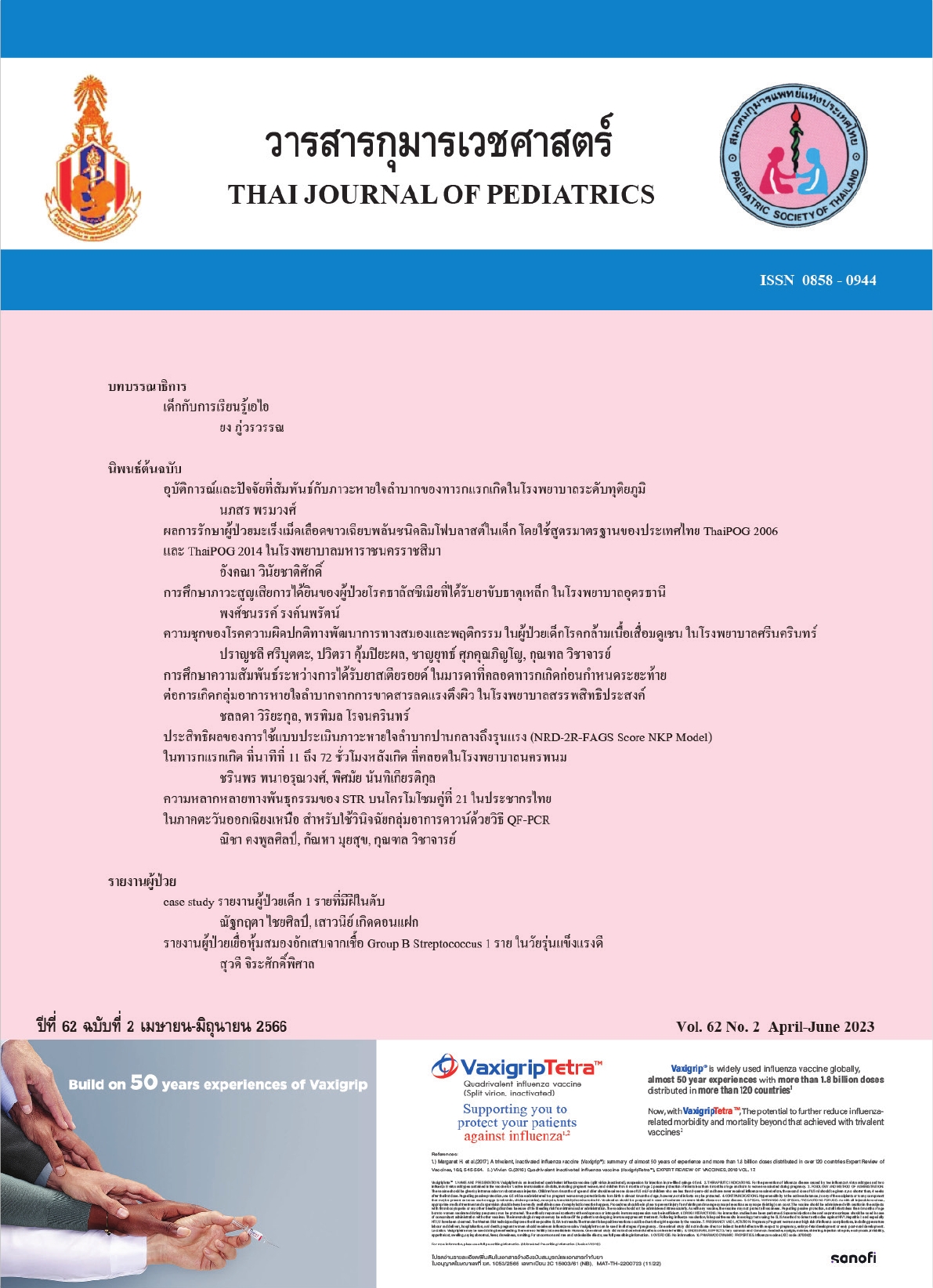Hearing loss in Iron chelated Thalassemic patientin Udonthani Hospital
Keywords:
thalassemia, iron chelation, hearing lossAbstract
Background: Thalassemia is a common disease in Thailand. Patients with thalassemia who need regular blood transfusions often develop iron overload which requires treatment with iron chelation. Following iron overload treatment, hearing loss has been reported with iron chelation, but the incidence and definitive risk factors for hearing loss are unknown.
Objectives: To determine the prevalence and the risk factors of hearing loss in thalassemia patients receiving iron chelation drugs in Udon Thani Hospital.
Methods: A retrospective study collecting data from medical records of thalassemia patients receiving iron chelation drugs in Udon Thani Hospital. From January 1, 2017 to July 15, 2022 and continue to follow up on treatment, collect demographics and thalassemia data, treatment results and hearing test results (audiogram auditory steady-state reponse: ASSR and distortion product otoacoustic emission: DPOAE). Data were analyzed using STATA (version 15).
Results: 100 patients, 50 males (50%), mean age 9.51 years, 28 (28%) patients with thalassemia. Patients in the abnormal hearing test group had beta-thalassemia hemoglobin E 10%, a mean pre-treatment ferritin level of 1757.72 ng/ml and a mean serum ferritin level greater than 1000 ng/ml was 55.25 months. The mean deferoxamine (DFO) dose was 25.84 mg/kg/day, mean DFO duration was 25.14 months. The mean deferiprone (DFP) was 82.68 mg/kg/day, mean DFP duration was 31.44 months The mean deferasirox (DFX) was 23.29 mg/kg/day period, mean DFX duration was 16 months, this data were not different from the normal hearing group (p-value > 0.05). The number of hearing loss in 35 ears was at 8000 Hz, which was the most at 42.85%. This study found that sex, age, weight, type of thalassemia, ferritin level before receiving iron chelation, ferritin level before the hearing test, duration of ferritin level greater than 1000 ng/ml, type of iron chelation, neither was a risk factor for hearing loss (p-value > 0.05).
Conclusion: The prevalence of hearing loss was 28 percent, with most hearing loss at a frequency of 8000 Hz, and no obvious risk factors for hearing loss were found in this study (p-value > 0.05).
Downloads
References
Barratt PS, Toogood IR. Hearing loss attributed to desferrioxamine in patients with beta-thalassaemia major. Med J Aust. 1987; 147:177-9.
Shamsian BS, Aminasnafi A, Moghadassian H, et al. Sensory neural hearing loss in beta-thalassemia major patients treated with deferoxamine. Pediatr Hematol Oncol. 2008;25:502-8.
Khan MA, Khan MA, Seedat AM, et al. Sensorineural Hearing Loss and Its Relationship with Duration of Chelation Among Major β-Thalassemia Patients. Cureus. 2019 ;11:e5465.
Tanphaichitr A, Kusuwan T, Limviriyakul S, et al. Incidence of ototoxicity in pediatric patients with transfusion-dependent thalassemia who are less well-chelated by mono- and combined therapy of iron chelating agents. Hemoglobin. 2014;38:345- 50.
Osma U, Kurtoglu E, Eyigor H, Yilmaz MD, Aygener N. Sensorineural hearing loss in β-thalassemia patients treated with iron chelation. Ear Nose Throat J. 2015;94:481-5.
Tartaglione I, Carfora R, Brotto D, et al. Hearing Loss in Beta-Thalassemia: Systematic Review. J Clin Med. 2021;11:102.
Porter JB, Jaswon MS, Huehns ER, East CA, Hazell JWP. Desferrioxamine Ototoxicity: Evaluation of Risk Factors in Thalassaemic Patients and Guidelines for Safe Dosage. Br. J. Haematol. 1989;73:403-409.
Kontzoglou G, Koussi A, Tsatra J, et al. Sensorineural Hearing Loss in Children with Thalassemia Major in Northern Greece. Int. J. Pediatr. Otorhinolaryngol. 1996;35: 223-230.
Wonke B, Hoffbrand AV, Aldouri M, et al. Reversal of Desferrioxamine Induced Auditory Neurotoxicity during Treatment with Ca-DTPA. Arch. Dis. Child. 1989;64: 77-82.
Chiodo AA, Alberti PW, Sher GD, Francombe WH, Tyler B. Desferrioxamine Ototoxicity in an Adult Transfusion-Dependent Population. J. Otolaryngol. 1997;26:116-122. [PubMed]
Gallant TM, Boyden H, Gallant LA, Carley H, Freedman MH. Serial Studies of Auditory Neurotoxicity in Patients Receiving Deferoxamine Therapy. Am. J. Med. 1987;83:83,1085-90.
Bhardwaj V, Verma R, Chopra H, Sobti P. Chelation-induced ototoxicity in thalassemic patients: Role of distortionproduct otoacoustic emissions and various management parameters. Indian J. Otol. 2016;22:193-198.
Humes LE. The World Health Organization’s hearing-impairment grading system: an evaluation for unaided communication in age-related hearing loss. Int J Audiol. 2019;58:12-20.
World Health Organization. 1991. “Report of the Informal Working Group on Prevention of Deafness and Hearing Impairment: Programme Planning. WHO/PDH/91.1.” Geneva, Switzerland: WHO.
World Health Organization. 2001. International Classification of Functioning, Disability and Health. Geneva, Switzerland: WHO.
Downloads
Published
How to Cite
Issue
Section
License

This work is licensed under a Creative Commons Attribution-NonCommercial-NoDerivatives 4.0 International License.



